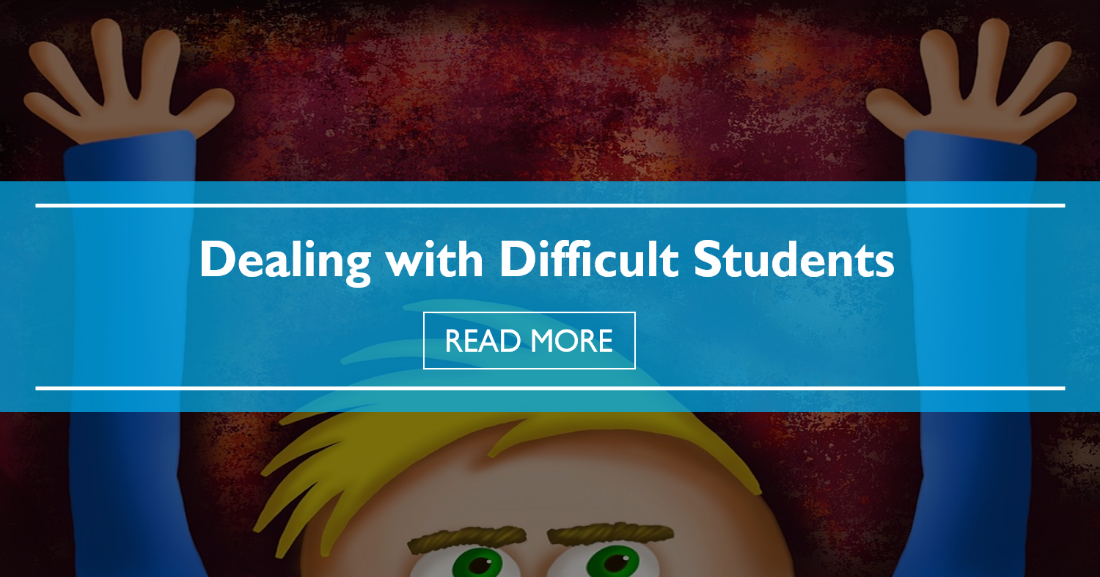Dealing with Difficult Students


Problem students are challenging because they may disrupt the learning environment, make your job more difficult than it has to be or just plain frustrate you and the other students. We’ve outlined four types of problem students and provided several strategies to deal with them. You will be able to spot these personality types from a mile away!

It’s pretty easy to identify the prospective problem student from the get-go. Always go with your gut and diagnose the issue as early on as you can. That is half the battle. The sooner you recognize the problem student the sooner you can begin working on your strategies to alleviate the issue and get the student on track.
Some students are overzealous, rambunctious, loud talkers or just plain annoying. This is usually the student who may be above his classmates in speaking ability, but not necessarily in overall language skills. They tend to display helpful nature, but may chronically interrupt, talk way too much or for two long, and in extreme cases may try to challenge you in front of the class. The best way to deal with this type of student is to provide appropriate times where he or she can be the leader, but set very firm boundaries. You need to make it clear to them that you are facilitator which basically means you are running the show. They can have their forum occasionally and often have a lot of good ideas and questions to contribute. You don’t want to shut them down completely. I’ve found that if you can disengage them in the class when they are getting off topic or stealing the spotlight, they generally get the hint. Other times it may take a private conversation. That conversation needs to be treated delicately as this type of student usually gets a bruised ego pretty easily. Give them guidelines for how long they are allowed to have the floor, and show them each and every time that you are the decision-maker in the class.
If anyone has worked in Asia or has Asian students, we have all encountered this student. They are usually female, afraid to speak, won’t make eye contact, and generally want someone to translate for them. This is a delicate situation and it takes some grace and humor to reach them and pull them out of their shell. Give them time and take baby steps. If everyone is asking and answering questions, expect that they will do almost nothing until they reach a certain comfort level. Don’t pressure them too much, but try to get them to at least repeat after you and praise anything that they do contribute. The other trick to this personality is to use her classmates to break through. They will instinctively try to help, so let them. Students like this are more apt to start sharing with someone from their own country or someone very similar to themselves. Put her in pairs with someone who will be gentle, and chances are that student will reach her. You can also try to approach something that will get a reaction out of the student. Maybe she really likes to eat sweets. Try a little bribery. Or maybe she is very close to her family, so the lesson on family may get her to respond. Keep trying and don’t give up. Persistence is key with this one, and the student will eventually come around.
I’ve encountered this guy way too many times for my taste. This is the guy who is taking an English class to try to get a date either with other students or with the teacher. It is usually a man, but some women can also be inappropriately flirtatious in the class as well. First do not engage this behavior. A few times you may be able to laugh it off, but with this type of problem student, you are going to have to tell them what is appropriate (and not) for the classroom. You may have to disengage the behavior a few times publicly, and then take him or her aside and give them the boundaries talk. In some cases the student doesn’t realize why their actions are inappropriate. One tactic may be to teach a lesson on body language, pick-up lines, or relationships. That way are able to approach the sensitive topics as a group and get some dialogue happening.
The refuser is different from the painfully shy. The refuser never wants to participate and feels that they don’t have to do the same level of work as everyone else. Often they don’t do their homework, will clam up during activities, and also may challenge you in front of the class because they are unprepared. This type of student can be really frustrating as you start wondering why they are in the class in the first place. One way to reach them may be soft public humiliation, meaning that you put him or her on the spot when they should be prepared and see what happens. With younger learners just being called out and not being ready is often enough for them to start applying themselves. You can also apply some discipline. Give the student double the amount of homework and follow through. Ask them if they need extra help and pair them with a student who can be a good role model. You can also try and set goals for this student. For every three days in a row that you participate you get 5 minutes extra of break time. The incentive should be small but meaningful and should also be applied to the whole class not just the problem student.
Occasionally though, you may come across one of these problem students. Always be sure to keep your cool, apply patience instead of pressure and realize that you have the facilities to solve student issues.
Do you have any of the above types of problem students in your classes? Tell us!